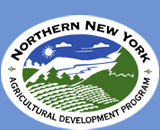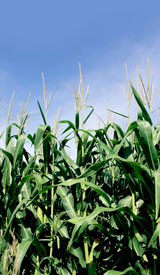September 16, 2009
Contact: Jessica Prosper, 518-483-7403, or Cornell Cooperative Extension
(list below)
It’s NNY Beef Week! Fall 2009 Focus is on Better Animal
Selection
Northern New York – Better animals, better beef. A series of workshops
in October will help Northern New York livestock producers select better
breeding bulls and replacement cows for beef production. The workshops
are part of a project funded by the farmer-driven Northern New York
Agricultural Development Program (NNYADP).
Specific topics at the workshops include the use of technology such as
ultrasound to select replacement animals and the hows and whys of
artificial insemination, including reading bull proofs, identifying when
cows are ready for breeding, and heat synchronization tools.
The ultrasound portion of the October workshops is a follow-up to
scanning demonstrations held on regional farms in May 2009 as part of
the NNYADP grant project. A series of workshops in 2008 introduced beef
producers to ultrasound and how it can be used to evaluate animals.
“Because the adoption of ultrasound technology is important to the
viability of agricultural in the region, the Northern New York
Agricultural Development Program agreed to fund anther series of
workshops in 2009 to encourage producers to incorporate its use into
their management practices,” says project leader Jessica Prosper, a farm
business management educator with Cornell Cooperative Extension of
Franklin County.
Heather Birdsall with Cornell Cooperative Extension of Cortland County
is New York’s only beef ultrasound technician. She says, “The best time
to ultrasound animals is when they become yearlings, which is usually in
the spring and fall of the year. I try to group producers in an area to
take advantage of this tool that provides them with data to better
select animals, particularly heifers, for breeding or culling to improve
their herds.”
Prosper notes that “the initial NNY Beef Week workshops provided farmers
with the opportunity to have animals scanned at a reduced cost. After
the animals were scanned, the images were sent to an Ultrasound
Processing Lab in Iowa for interpretation. As a follow-up now, in
October, Cornell Cooperative Extension Beef Cattle Specialist Mike Baker
will explain how the interpreted results can be read used to make better
management decisions on the farm through better animal selection,”
Prosper says.
It is not necessary for farmers to have attended the meeting in May 2009
to participate in the October workshops scheduled for:
• Tuesday, October 6: 6:30-9 pm, Cornell Cooperative Extension of
Jefferson County, Watertown, contact: Ron Kuck, 315-788-8450,
rak6@cornell.edu
• Wednesday, October 7: 6:30-9 pm, Ausable Valley Grange, Keeseville,
contact: Peter Hagar, 518-561-7450,
phh7@cornell.edu
• Thursday, October 8: 6:30-9 pm, North Country Community College,
Malone, contact: Jessica Prosper, 518-483-7403, jlr15@cornell.edu
• Friday, October 9: 6:30-9 pm, Cornell Cooperative Extension of St.
Lawrence County Learning Farm, Canton, contact: Betsy Hodge:
315-379-9192, bmf9@cornell.edu.
The Northern New York Agricultural Development Program is a
farmer-driven initiative to ensure the long term economic vitality of
Northern NY’s agricultural production sector and agriculture’s important
contributions to the protection and enhancement of the region’s
environment and rich natural resource base and to communities in New
York State’s six northernmost counties.
The Northern New York Agricultural Development Program awards grants for
practical on-farm research, outreach and technical assistance and is
supported by funds from the New York State Legislature through the long
term support of the North Country’s State Senators, and with the support
of NYS Assemblypersons from the region and other areas of the state.
The
program receives support (funds, time, land, expertise, etc.) from
Cornell University’s College of Agriculture and Life Sciences, the
Cornell University Agricultural Experiment Station, the NYS Agricultural
Experiment Station in Geneva, the six Northern New York Cornell
Cooperative Extension Associations, the W. H. Miner Agricultural
Research Institute, the U.S. Department of Agriculture, the New York
State Department of Agriculture and Markets, cooperating farms,
agribusinesses across the region, and others.
To learn more about the Northern New York Agricultural Development
Program, go online to www.nnyagdev.org, contact program co-chairs Jon
Greenwood at 315-386-3231 or Joe Giroux at 518-563-7523, or call your
local Cornell Cooperative Extension office. # # #
Background
What is Real-Time Beef Carcass Ultrasound? by Heather Birdsall, Senior
Extension Resource Educator, Cortland County Cornell Cooperative
Extension
So, what is real-time ultrasound? Real-time ultrasound uses high
frequency sound waves to “see” under the hide while the animal is still
alive. This is the same technology used for pregnancy diagnosis in
livestock as well as humans. This process is harmless to the animal and
technician. These images make it possible to evaluate the carcass
quality of live animals previously possible only through the direct
measure on a hanging carcass following harvest. This allows a manager to
directly determine the carcass characteristics of replacement stock as
compared to evaluation-harvested progeny.
In the application of real-time beef carcass ultrasound, specific
equipment is needed to collect and analyze the scanned images of the
beef animal. There are two major types of ultrasound machines being used
for carcass evaluation of beef cattle: the Aloka 500 and the Classic PIE
Scanner 200. These machines consist of a console unit that contains the
electronics, controls, and a screen upon which the ultrasound image is
visualized by the technician. The sound-emitting probe, called a
transducer, is attached to the ultrasound machine. Once placed on the
animal, the transducer emits ultrasonic waves, which bounce off the
boundaries between fat and muscle. The echoes returning to the
transducer are detected and translated into images that are displayed on
the ultrasound machine screen. A standoff pad is a made of a pliable
"super flab" material and is placed on the transducer. This allows it to
fit the natural curvature of the animal assisting in the collection of
the ribeye image. A chute side video monitor, external monitor, is also
used when ultrasounding cattle to help insure quality images are taken.
And lastly, an image capturing system, called a Black Box, is needed to
capture and save images to a zip disk for processing purposes.
Real-time live animal carcass ultrasound can be a very beneficial
production practice for all segments of the beef industry. This
technology is being utilized across the nation by progressive purebred
and commercial producers and buyers as they integrate more carcass
information into their selection programs. The use of live-animal
carcass ultrasound is just one step towards reaching the goal of
producing a high quality, consistent product for today’s value-based
market.
Additional Contacts:
Cornell Cooperative Extension Livestock Educators for Northern NY:
• Clinton County: Peter Hagar, 518-561-7450
• Essex County: Anita Deming, 518-962-4810
• Franklin County: Carl Tillinghast, Bernadette Logozar, 518-483-7403
• Jefferson County: Ron Kuck, 315-788-8450
• Lewis County: Michele Ledoux, Frans Vokey, 315-376-5270
• St. Lawrence County: Brent Buchanan, Betsy Hodge, 315-379-9192
Northern New York Agricultural Development Program:
www.nnyagdev.org



